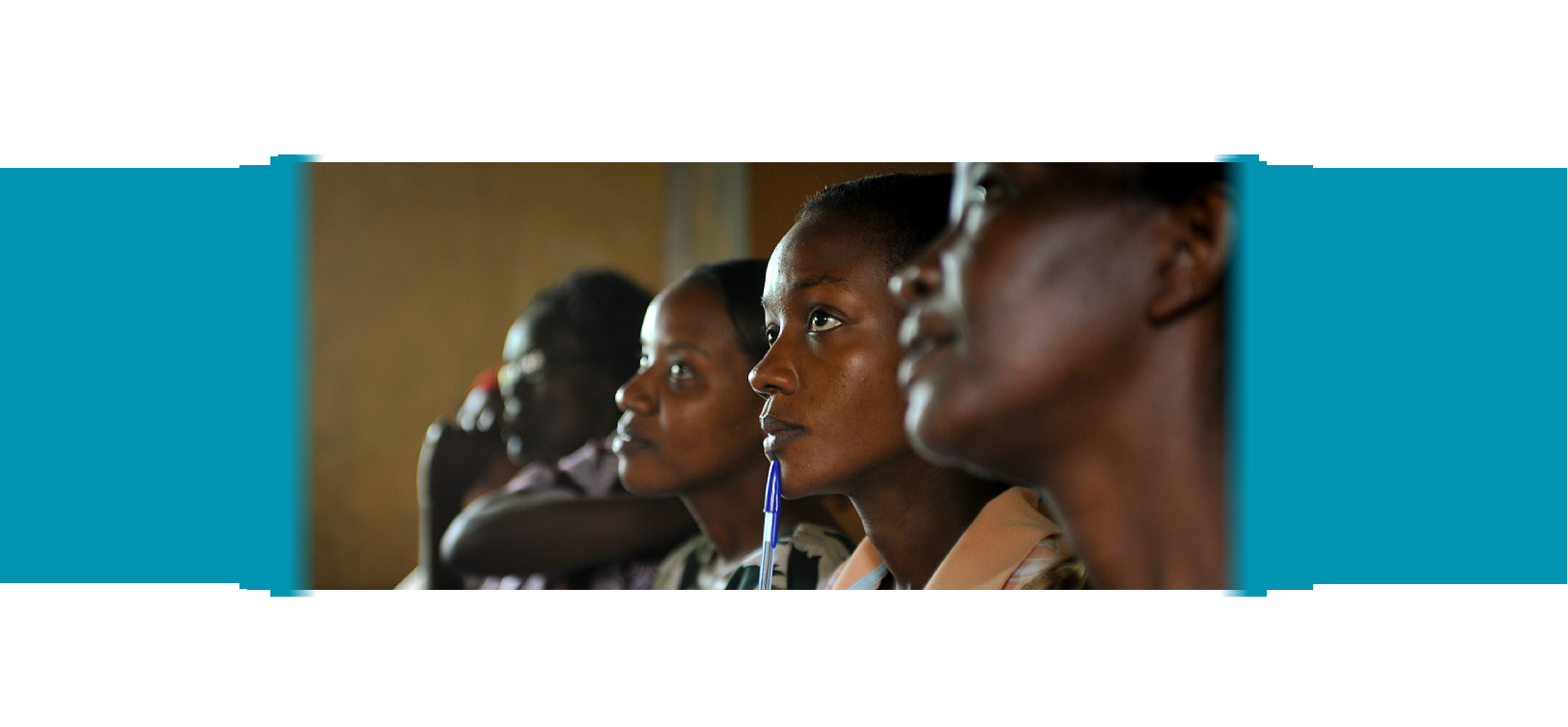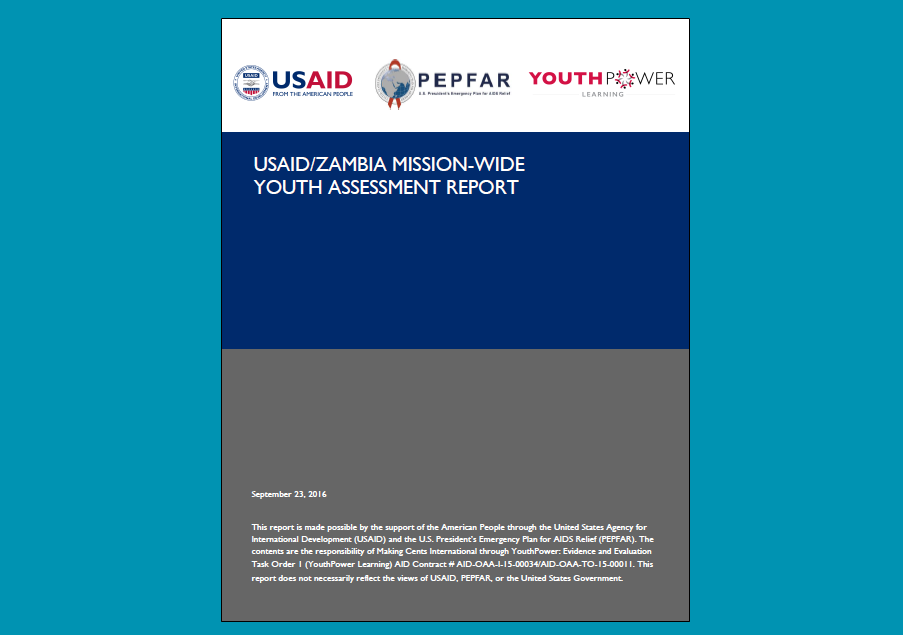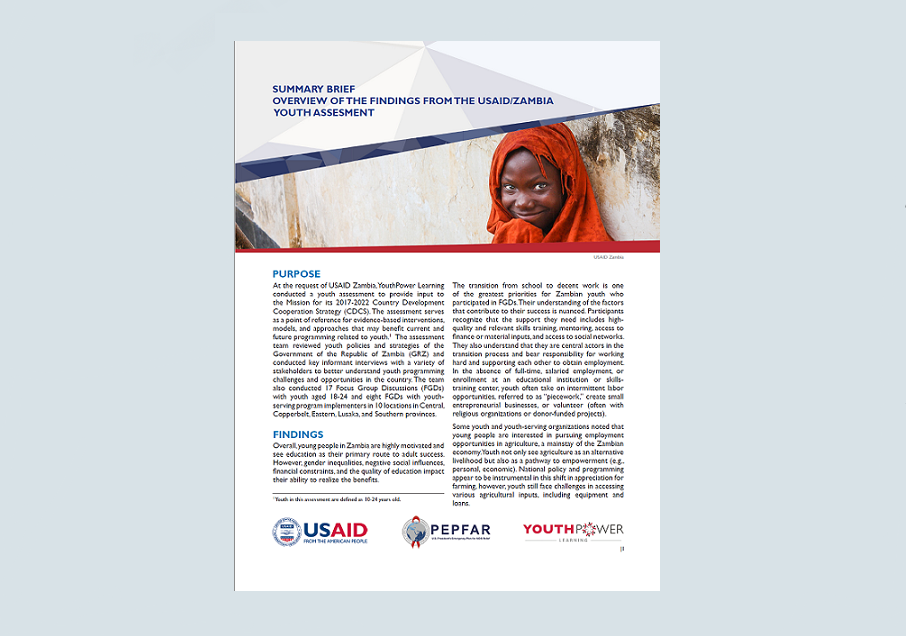
Project Prime and Partners
YouthPower Learning managed by Making Cents International (Prime)
International Center for Research on Women (Partner)
Khulisa Management Services (Partner)
Key Researchers
Gary A. Walker, Making Cents International
Kathryn Green, Making Cents International
Zayid Douglas, International Center for Research on Women
Christian Chileshe, Khulisa Management Services
Publication Date
September 23, 2016
Project Goals
The goal of the USAID/Zambia Mission-Wide Youth Assessment (MWYA) is to provide input to the Mission for its 2017-2022 Country Development Cooperation Strategy (CDCS), to serve as a point of reference for evidence-based interventions, models and approaches that may benefit current and future USAID/Zambia programming related to youth (defined as 10-24 year olds), and to consider the rationale, merits and possible framework of a Mission youth strategy. The assessment team was asked to examine program challenges and opportunities, to review youth policies and strategies of the Government of the Republic of Zambia (GRZ) and other stakeholders, to ensure that the views of youth are fully considered and to make recommendations based on the findings of the team.
Brief Background
About 35 percent of Zambia’s population is aged 10-24 and 74 percent are under the age of 30. Within this group, about 15.5 percent are from 10-14 years of age and 16.8 percent are aged 15-24. Zambia has a median age of 16.6 compared to a world average of 29.2 and a very high fertility rate even for Africa at more than five live births per woman compared to Zimbabwe at 3.56, Botswana at 2.66 and South Africa at 2.41.
Statistics provide a profile of the challenges facing youth but they do not convey the whole story. Despite real challenges exacerbated by widespread poverty, there are young people that have identified issues around services or hazards in their communities, conducted assessments, created youth programs, and launched their own community-based organizations and non-governmental organizations that have sustained their efforts, impacting tens of thousands of others. The statistics also do not capture the peer educators from small rural communities who, as a result of learning, some training and leadership skills, go on to participate in national and global-level health platforms, benefitting thousands of other young people. Finally, with the support of the U.S. Department of State, USAID and others to the Young African Leaders Initiative (YALI), a new generation of youth leaders is emerging with a commitment to development, good governance and human rights.
There is also the positive context for youth development constructed by government agencies, development partners, NGOs and others who support and motivate young people to help prevent HIV, reduce poverty, improve food security, end gender-based violence (GBV), care for orphans and vulnerable children (OVCs) and support universal human rights. Young people represent an enormous pool of human potential and already possess many assets and talents that well-designed initiatives can build upon.
The PYD approach helps to identify and nurture those talents and then empowers youth to apply their abilities in more positive and enabling environments. USAID is a leader, funding and facilitating efforts to build a better development narrative and is now considering how that narrative may be more explicitly youth-focused. By doing so, it will become better positioned to seize opportunities provided by Zambia’s demographic “youth bulge” and mitigate challenges.
Key Findings
This assessment recommends linking a PYD framework with economic value chains in rural and urban areas to create new opportunities for youth to achieve improved health and education and to improve prospects for youth to escape poverty and become productive, contributing citizens with sustainable livelihoods. Government officials, development partners, NGO representatives and, in some cases, youth at FGDs identified similar challenges and recommendations:
- Make an explicit commitment to a youth focus in the next CDCS using a PYD approach.
- Strengthen district and local level capacities of the GRZ, local NGOs and other local entities to enhance implementation of youth-focused activities.
- Strengthen youth-led organizations at the district level and below to build youth leadership and participation by funding what works based on lessons learned.
- Consider new programming for youth in economic development, health and other targeted sectors to increase opportunities for more pathways to decent work.

Document Details
Title: USAID/Zambia Mission-Wide Youth Assessment Report
Sponsoring Organization: USAID, Mission to Zambia
Language: English
File Size: 1865 KB
Download the document.
Share this document.
Document Details
Title: Summary Brief: Overview of the Findings from the USAID-Zambia Youth Assessment
Sponsoring Organization: USAID, Mission to Zambia
Language: English
File Size: 3070 KB


